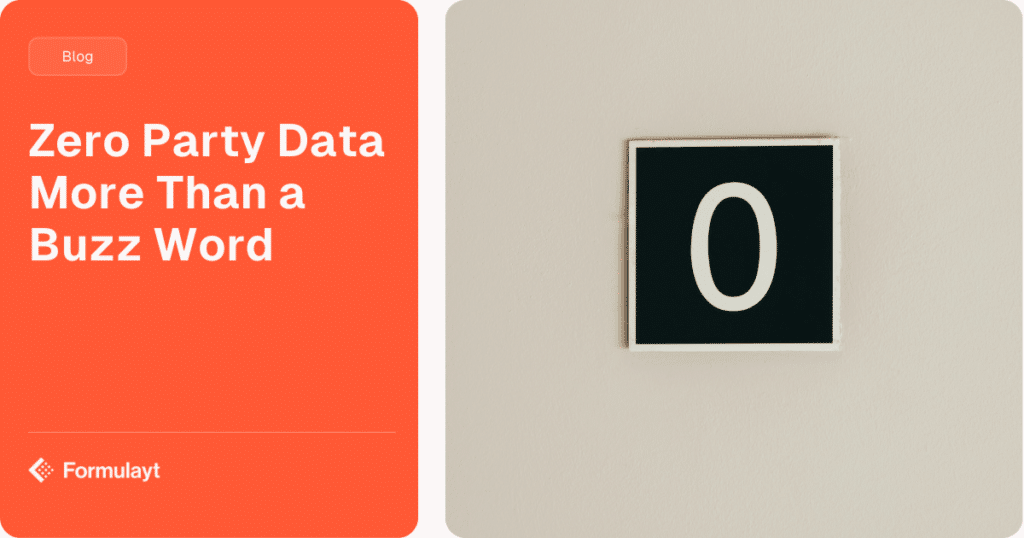Zero Party Data is more than a new marketing buzzword

Zero Party: Strategy, Implementation and Benefits
Zero Party data may sound like the next big thing in a long line of “must haves” when it comes to marketing buzzwords. The recently coined phrase, was first seen in a Forrester report, last year. What is it exactly? Do you really need to be thinking about it? And, if so, how quickly can you start capturing ZPD? This article looks at Zero Party data and how it fits within your data strategy. The good news is, you might already be gathering it.
What is Zero Party data?
Let’s start with the basics. Buyers hold more and more control when it comes to the types of data we hold. Privacy concerns are growing daily and restrictions like GDPR are increasingly limiting. Enter Zero Party Data (ZPD), which builds trust with your buyers and creates a certain level of emotional connection. Thus encouraging your leads to part with more of their data voluntarily.
Think about First Party data. It used to be defined as preference data, as it’s down to your lead or buyer to provide this information. Different from third party data, which is provided as a purchased list or as data that has been approved for distribution by a “third party”. First Party data used to be the big player – in order to gain it, organizations usually need a content value exchange. In the world of data, people rarely give it away for free.
ZPD is closely linked to first party data, but more personal, more preference-driven and obtained in a voluntary way. In a recent Forrester report, zero-party data (ZPD) is data a customer shares with a brand in an intentional and proactive manner. It might include first party data but it also includes purchase intentions and ultimately how a person wants to be recognized by a brand.
The difference between first party and zero party data is that first party data is closely linked to inferred purchase intention based on behavioural data (like number of clicks through from an email campaign) and ZPD is linked to direct intentions as it comes from a customer’s willingness to share data as a result of company interest.
Tim Bohn, Head of Product at Formulayt Solutions, states “ZPD is the type of data that a brand asks customers for – and that customers feel they want to share with the brand.”
How to gather Zero Party Data
To put ZPD into context, think about types of data that organisations directly request through content gating. customer surveys, competitions and questionnaires, for example. The feedback received by customer surveys is data that a customer wants to share. By using this data appropriately, companies can tailor their products and services to the wants and needs of consumers.
Although ZPD as a phrase was only coined in 2018, it’s application is not necessarily new. What ZPD is, is personal. It’s a quirky poll, a social media quiz, an interactive ad. It speaks directly to your customer and asks them to share their information by offering a high value exchange: a piece of content, a chance to win a prize or even recognition on a social channel.
Our customers want to be engaged, dazzled and enticed to share their data. With this in mind, innovative uses of ZPD include digital experiences with the option to opt-in, conduct market research and create unique user experiences which encourage people to act and engage with your brand.
ZPD is best suited to marketers who aim to be digital disruptors. Gaining traction through social channels by offering a unique experience will only help encourage more activity from audiences. However, this is not the only way to gain traction. Companies are gathering ZPD through a question in an Ad campaign or even through a gated content form on their website. The idea behind ZPD is to be personal, direct and open about your clients needs. The way you interact with your potential customers should be personal but not invasive.
Data Governance
ZPD is collected using social surveys, ad campaigns and gated website content (including questionnaires and competitions). Large global companies will have a multitude of languages, privacy policies and data quality guidelines to conform to. It can become extremely difficult and costly to manage and scale this level of gated content.
Formulayt Solutions is able to discuss your company’s data governance and gated content requirements on a small, medium or global scale. Zero Party data is a direct conversation with your potential customers. Don’t lose a precious opportunity to find out more about your users. Speak with us today to find out how you can benefit from a Zero Party data strategy.
